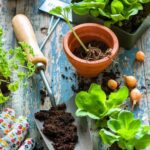Are you looking to enhance the growth of your vegetable garden? Discover how to use blood meal in vegetable gardens to maximize plant health and yield. Blood meal is a valuable organic fertilizer that provides essential nutrients for your plants. From understanding its nutritional benefits to proper application techniques, this article will guide you through everything you need to know about utilizing blood meal effectively in your vegetable garden.
Blood meal, a natural byproduct of the meat industry, is a rich source of nitrogen, phosphorus, and potassium – all vital nutrients for plant growth. Its high nitrogen content makes it an excellent choice for promoting lush green foliage and overall plant development. Additionally, blood meal improves soil fertility and enhances microbial activity, contributing to healthy and vibrant vegetable crops.
When it comes to using blood meal in your vegetable garden, proper application is key. It’s essential to understand the quantity and frequency of application to avoid overfeeding or underfeeding your plants. By following the correct techniques, you can ensure that your vegetables receive the necessary nutrients for robust growth without any adverse effects.
In this comprehensive guide on using blood meal in vegetable gardens, we will delve into the myriad benefits of incorporating this organic fertilizer into your gardening routine. From improved soil fertility to enhanced plant growth, learn how blood meal can elevate the health and productivity of your vegetable garden.
Understanding the Nutritional Benefits of Blood Meal for Vegetable Gardens
Blood meal is a natural fertilizer that is commonly used in vegetable gardens to provide essential nutrients for plant growth. One of the main benefits of blood meal is its high nitrogen content, which promotes leafy green growth and overall plant vigor. In addition to nitrogen, blood meal also contains phosphorus and potassium, making it a well-rounded fertilizer for vegetables.
Nitrogen is a critical nutrient for plant growth as it is a major component of chlorophyll, the compound that allows plants to carry out photosynthesis. This means that nitrogen plays a vital role in the production of energy and food for the plant. Phosphorus is important for root development and overall plant health, while potassium helps with disease resistance, water retention, and the overall strength of the plants.
When using blood meal as a fertilizer in vegetable gardens, it’s important to understand how these essential nutrients work together to support healthy plant growth. By providing an ample supply of nitrogen, phosphorus, and potassium through the use of blood meal, gardeners can ensure that their vegetable plants have everything they need to thrive and produce bountiful harvests.
| Nutrient | Role in Plant Growth |
|---|---|
| Nitrogen | Promotes leafy green growth and overall plant vigor; major component of chlorophyll for photosynthesis |
| Phosphorus | Important for root development and overall plant health |
| Potassium | Supports disease resistance, water retention, and overall strength of plants |
Proper Application Techniques
Measuring and Applying Blood Meal
When using blood meal in vegetable gardens, it is essential to follow proper application techniques to ensure optimal plant growth and soil fertility. The recommended quantity of blood meal to use varies depending on the specific needs of the garden and the existing nutrient levels in the soil.
As a general guideline, a typical application rate for blood meal is about 1 pound per 100 square feet of garden space. However, it’s crucial to conduct a soil test to determine the exact nutrient requirements of your vegetable garden before applying blood meal.
Frequency of Application
In terms of frequency, blood meal can be applied either as a one-time dose at the beginning of the growing season or as multiple smaller applications throughout the year. For heavy-feeding vegetables like tomatoes or squash, it may be beneficial to apply blood meal two to three times during the growing season to support their high nutrient demands.
On the other hand, for low-feeding vegetables such as beans or peas, a single application at planting time could be adequate.
Application Method
When applying blood meal to your vegetable garden, it’s important to mix it thoroughly into the soil to prevent nitrogen loss through volatilization. You can either spread the blood meal evenly over the garden bed and then work it into the soil with a rake or hoe, or you can dilute it in water and apply it as a liquid fertilizer.
Additionally, watering your garden after applying blood meal will help incorporate it into the soil and make it more readily available to plants.
By understanding proper application techniques for using blood meal in vegetable gardens – including measuring and applying precise quantities, determining frequency of application based on plant needs, and utilizing effective methods for incorporating blood meal into the soil – you can maximize its benefits for nurturing healthy and productive vegetable plants.
Benefits of Using Blood Meal in Vegetable Gardens
Using blood meal in vegetable gardens can offer a range of benefits that contribute to the overall health and productivity of the plants. When used correctly, blood meal can enhance soil fertility and promote robust plant growth.
Improved Soil Fertility
Blood meal is a rich source of nitrogen, which is an essential nutrient for plant growth. Nitrogen is necessary for the development of lush, green foliage and plays a crucial role in the photosynthesis process. By incorporating blood meal into the soil, vegetable gardeners can improve the overall fertility of their garden beds, ensuring that plants have access to the nutrients they need to thrive.
Enhanced Plant Growth
In addition to its nitrogen content, blood meal also contains other important nutrients such as phosphorus and potassium. These nutrients play key roles in various aspects of plant development, including root growth, flower formation, and overall resilience to stressors. As a result, the use of blood meal in vegetable gardens can lead to enhanced plant growth, healthier crops, and increased yields.
Environmentally-Friendly Option
Another advantage of using blood meal in vegetable gardens is that it provides a natural and environmentally-friendly approach to fertilizing plants. Blood meal is derived from animal sources and is considered an organic fertilizer, making it a suitable choice for gardeners who prioritize sustainability and eco-conscious practices. Additionally, because it slowly releases nutrients over time, blood meal supports long-term soil health without causing detrimental impacts on the environment.
Potential Risks and Precautions
Blood meal is a valuable source of nutrients for vegetable gardens, but its use also comes with potential risks and precautions that gardeners need to be aware of. One of the main drawbacks of using blood meal is its high nitrogen content, which can lead to excessive soil acidity if over-applied.
This can negatively impact plant growth and overall soil health. Additionally, some gardeners may find the smell of blood meal unpleasant, making it important to take proper handling and storage precautions.
To mitigate the risks associated with using blood meal in vegetable gardens, it is crucial to follow application guidelines carefully. Blood meal should be applied sparingly and according to the specific needs of your plants and soil.
It should never be used in excess or as a quick fix for poor soil health. Additionally, it’s important to avoid direct contact with blood meal when handling it, as it can cause skin and eye irritation due to its high nitrogen levels.
When storing blood meal, it should be kept in a cool, dry place away from moisture and direct sunlight. Moisture can cause the blood meal to clump or become rancid, reducing its effectiveness as a fertilizer. By taking these precautions when using and storing blood meal, gardeners can ensure that they maximize its benefits while minimizing any potential risks associated with its usage.
| Potential Risks | Precautions |
|---|---|
| Excessive nitrogen content leading to soil acidity | Follow application guidelines carefully; avoid over-application |
| Unpleasant smell | Handle and store blood meal properly; avoid direct contact |
| Skin and eye irritation | Avoid direct contact when handling; wear protective gear if necessary |
Choosing the Right Blood Meal for Your Vegetable Garden
When it comes to choosing the right blood meal for your vegetable garden, there are a few different options available on the market. Each type of blood meal may vary in terms of its nutrient content, origin, and processing methods. Here are some of the main types of blood meal to consider for your garden:
- Organic Blood Meal: This type of blood meal is sourced from organically-raised animals and is processed without the use of synthetic chemicals or additives. It’s an excellent choice for organic gardening practices and provides a reliable source of nitrogen for your plants.
- Synthetic Blood Meal: Unlike organic blood meal, synthetic blood meal is typically derived from conventionally raised animals and may contain additives or preservatives. While it can still be effective as a fertilizer, it may not align with the principles of organic gardening.
- Bone Meal with Blood: Some blood meal products also contain bone meal, which provides an additional source of phosphorus for plants. This combination can be particularly beneficial for flowering and fruiting vegetables that require higher levels of phosphorus for optimal growth.
Before selecting a blood meal for your vegetable garden, it’s important to consider your specific gardening needs and preferences. Factors such as budget, desired nutrient balance, and ethical considerations regarding animal products may influence your decision.
Ultimately, choosing the right blood meal for your vegetable garden involves finding a product that aligns with your values and meets the nutritional requirements of your plants. Whether you opt for organic or synthetic blood meal, be sure to follow the recommended application rates and guidelines provided by the manufacturer to achieve the best results in your garden.
By selecting a high-quality blood meal product that suits your needs, you can effectively enhance the fertility and overall health of your vegetable garden.
Complementary Gardening Practices
When using blood meal in vegetable gardens, it is important to consider how to integrate its application with other gardening techniques to maximize its benefits. Composting is a valuable practice that can complement the use of blood meal in vegetable gardens.
By adding blood meal to a compost pile, you can enhance the nutrient content of the compost, which will ultimately improve the soil fertility when the compost is applied to the garden. Additionally, incorporating crop rotation into your gardening practices can help ensure that different areas of the garden benefit from the use of blood meal over time.
To effectively integrate blood meal application with composting, consider creating a balanced mix of organic materials in your compost pile. This can include kitchen scraps, yard waste, and other organic matter, along with a suitable amount of blood meal. Turning the compost pile regularly will help accelerate the decomposition process and promote even distribution of nutrients, resulting in high-quality compost that can be used as a natural fertilizer for your vegetable garden.
Incorporating crop rotation into your gardening practices can also optimize the benefits of using blood meal in vegetable gardens. By rotating crops throughout different sections of your garden each season, you can prevent nutrient depletion in the soil and reduce the risk of pests and diseases that may be specific to certain plant species.
When applying blood meal to fertilize the soil for specific crops, taking into account their nutrient requirements and growth patterns will allow for more targeted and efficient use of this organic fertilizer.
Troubleshooting Common Issues
In conclusion, while using blood meal in vegetable gardens can provide numerous benefits such as improved soil fertility and enhanced plant growth, it is essential to be aware of potential issues that may arise. One common problem gardeners may encounter is over-application of blood meal, which can lead to nitrogen burn in plants.
To avoid this, it is important to follow the recommended application rates and frequency provided on the product packaging or by a gardening expert. Additionally, choosing the right type of blood meal for your specific garden needs can also help prevent potential issues.
Another issue that may occur when using blood meal in vegetable gardens is attracting animals such as dogs, cats, or rodents due to the strong scent of the product. To mitigate this problem, consider mixing the blood meal into the soil thoroughly or covering it with a thin layer of mulch to help reduce the odor. It is also important to store any unused blood meal in a secure container away from animals.
Furthermore, some gardeners may experience challenges with the effectiveness of blood meal in certain soil conditions. If you notice that your plants are not responding well to the application of blood meal, consider conducting a soil test to understand its nutrient composition and pH level.
This will give you valuable insights into whether additional amendments are needed to optimize the benefits of using blood meal in your vegetable garden. By being proactive and taking these precautions, you can successfully troubleshoot common issues and maximize the advantages of incorporating blood meal into your gardening practices.
Frequently Asked Questions
How Do I Add Blood Meal to My Vegetable Garden?
To add blood meal to your vegetable garden, start by reading the instructions on the blood meal package to determine the appropriate application rate. Blood meal is a high-nitrogen fertilizer, so it’s best to apply it in smaller amounts and work it into the soil well.
It’s important to wear gloves and a mask when handling blood meal, as it can be an irritant. Once you’ve worked the blood meal into the soil around your vegetable plants, water the area thoroughly to help the nutrients become available to the plants.
Which Vegetables Benefit From Blood Meal?
Several vegetables benefit from the use of blood meal in their gardens. Leafy greens like spinach, lettuce, and kale are known for responding well to nitrogen-rich fertilizers like blood meal. Other nitrate-hungry vegetables such as corn, strawberries, and tomatoes can also benefit from being supplemented with blood meal in their soil.
What Plants Don’t Like Blood Meal?
While many plants thrive with blood meal application, some do not favor its use due to its high nitrogen content. Root vegetables like carrots and potatoes are sensitive to excess nitrogen and may develop an abundance of foliage at the expense of root development if given too much blood meal.
Additionally, legumes such as beans and peas have a natural ability to capture nitrogen from the air and therefore generally don’t need additional supplementation with blood meal.

If you’re looking to get into vegetable gardening, or are just looking for some tips on how to make your current garden better, then you’ve come to the right place! My name is Ethel and I have been gardening for years. In this blog, I’m going to share with you some of my best tips on how to create a successful vegetable garden.





